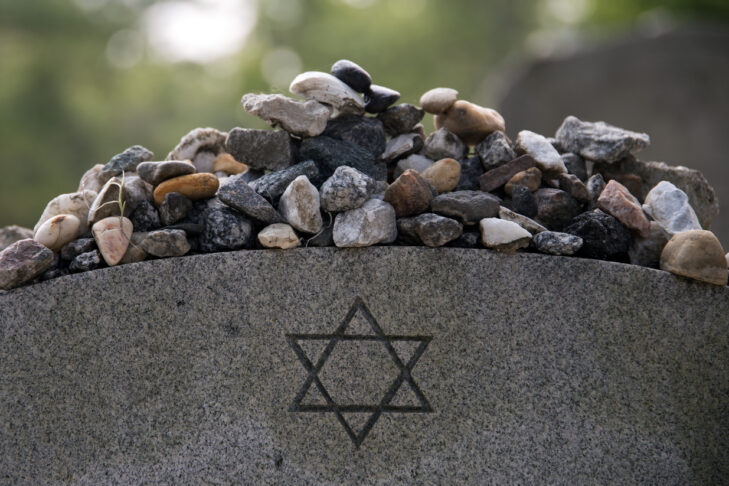This week I cried as I watched videos of two friends leaving health care facilities after having survived the novel coronavirus. Nurses, doctors, chaplains and everyone associated with their care applauded my friends. One was in a stretcher on his way to a rehab facility; the other walked out on his own power. Their ongoing recovery has taken weeks, if not months. This is what survival looks like in a pandemic. This is what joy looks like in a pandemic.
This fraught time has me thinking about the alliance between life and death. My friends, thank God, survived. I want to wrap every one of my superstitions around them to keep them safe and healthy going forward. But, as the superstitious side of me must note—l’havdil—my thoughts, must be separate. I read each obituary of those who have succumbed to the virus as if I’m reciting a Kaddish for them. These are people I will never meet. Nevertheless, their deaths have touched me. They are grandmothers, firefighters, artists, chefs, daughters, sons—all of them felled to this insidious, mysterious virus.
I read an article that brought home the love and kindness that accompanies Jewish burial. In Hebrew, it’s described as hesed shel emet: the truest act of kindness. The Hebrew Free Burial Association, a nonprofit organization that assures every Jew the dignity of a religious burial no matter their circumstances, could not keep up with the recent rate of deaths. Consequently, they were running out of tallitim, or prayer shawls, in which to wrap a body.
I called the association’s director of operations, Andrew Parver, and he confirmed what I had read. When people heard about the association’s dilemma, they donated tallitim in unprecedented numbers. “Once we hit into our reserves, we made an appeal,” Parver said. “We’ve been very inspired [by the response]. It’s beyond our wildest imagination.”
Parver asked for tallitim on the association’s Facebook page, as well as on local list servs. He said that almost immediately he was fielding calls from all over the country. The response has enabled the association to keep up with the unprecedented number of funerals it has overseen in the past couple months. Parver noted that in a given year, the association arranges almost 400 funerals. Last month, the number was over 100 funerals.
When I spoke to Parver, I had also been thinking about the pluralistic Community Hevra Kadisha of Greater Boston—another burial society with a sacred duty to prepare bodies for Jewish ritual burial. Last winter, Boston became the first community to complete “Toward a Gender-Inclusive Hevra Kadisha,” a comprehensive guide to gender inclusivity. James Cohen and Emily Fishman chaired the committee that was tasked to write guidelines and compose liturgy around the ritual of tahara—cleansing or purifying the body. “We put a lot of intentional thought to represent the wants and desires of the community,” Cohen said.
The needs of the community also included assurances to those who had identified as non-binary that they would be posthumously served according to their wishes. Rabbi Becky Silverstein reached out to the transgender and non-binary community on behalf of the Hevra Kadisha to determine priorities and needs. As he surveyed those communities, he saw it as “a moment where people’s voices could be heard and they could share their experiences. We were meaningfully helping to shape a project that was not just symbolic. We were saying to trans and non-binary people: Here’s a way in which people are working to make this tradition more accessible to you. People want to make your experience a part of what is happening in Judaism.”
Rabbi Emily Aviva Kapor Mater crafted liturgy for the Hevra Kadisha. Kapor Mater adapted a number of principles according to Jewish law in which “transgender status does not disqualify one from receiving tahara.” She went on to write about the “acknowledgment of the shameful reality that many Jewish communities’ discrimination against and oppression of their transgender and non-binary brothers, sisters, siblings, does not cease when they die.”
Kapor Mater’s rendition of the liturgy, the blessings she adapted for transgender and non-binary persons, take into consideration the person’s lived gender. She noted that certain texts and blessings can be an issue for non-binary people, as well as binary transgender people. Even cisgender people may be uncomfortable with verses from “Song of Songs.” “The verses,” writes Kapor Mater, “stress the ‘perfection’ of the body, which is a notion that people who went through life with dysphoria or dysmorphia and the like may not relate to.”
As the first burial society in the country to bring forward burial rituals and blessings for transgender and non-binary individuals, other Jewish burial societies have looked to Boston’s Hevra Kadisha for guidance. The questions can be complex. For example, who performs tahara on a non-binary person? In Boston, there’s a non-binary team ready to execute that ritual. What happens in other places where there are far fewer than 150 volunteers like in Boston?
Parver said his group has had occasion to arrange very few Jewish burials for transgender and non-binary people. “Our mission,” he said, “is to make sure that every Jewish person, when they die, will receive a proper, dignified funeral and burial. Every case is different, and we do our best to care for everybody to the best of our ability.”
Thank God my friends were blessed with the gift of life in this terrifying pandemic. And thank God there’s the Community Hevra Kadisha trailblazing the way for every Jew to receive what is rightfully theirs—a respectful, dignified Jewish burial complete with the appropriate rituals.
As Silverstein noted, “We have an opportunity to put something out in the world that can serve as a template. The Hevra Kadisha of Greater Boston took on the responsibility for creating [guidelines and adapting liturgy]. It’s a gift the Hevra Kadisha has given the community.”











